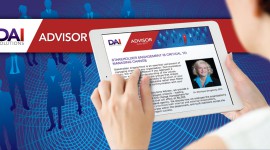21 Jan
2016
FLIPPING LEARNING ON ITS HEAD
cnguyen@dai-solutions.com
83
human capital strategy
,
learning
,
learning and development
,
limited budgets
,
performance
,
performance management
,
program effectiveness
0 Comments
For most of us, the idea of a classroom brings to mind a familiar image with a teacher at the front of the room and a class full of students eagerly (or sometimes not so eagerly) waiting to learn. From one generation to the next, the classroom concept hasn’t changed very dramatically. Teachers provide live instruction coupled with limited hands-on practice in the classroom. Additional practical exercises are assigned as homework that the students dutifully complete outside of class on their own without assistance or anyone to consult when they struggle. The model has been applied universally from elementary classrooms to senior-level leadership courses, and, despite dramatic advances in technology, the model persists. In the professional learning and development world, most courses, even those delivered virtually, follow a similar live-lecture and practice approach.
For government and corporate organizations, the new reality is that learning dollars are limited, travel budgets are disappearing, and there aren’t enough hours in the day to send employees away for days on end. But at the same time, the rapidly changing work landscape and the need to prepare workers for new challenges as well as personal and professional growth makes learning and development a crucial component of any long-term human capital strategy.
So what if we turned the classroom upside down? Our learning consultants are doing just that.
In a “flipped classroom,” in-person class time is spent on practical application and hands-on exercises, not lecture. Rather than an instructor at the front of the class, there is a facilitator who mentors and provides more personalized support while students work individually and on teams. It’s not a new concept, but it is an idea that is gaining momentum thanks to advances in technology that make it easier to produce and distribute materials for use outside of class. The traditional lecture is replaced by audio, video and multimedia assignments that are completed before class. Students are given access to these materials before the scheduled in-person class so they have an opportunity to view or listen on their own schedule prior to coming to class. Technologies like portable music players, smartphones and tablets make using these materials even more convenient. Once in class, rather than spending time on lecture, class time is spent applying the knowledge through practical exercises and hands-on activities with ad hoc reinforcing lessons as needed. As students apply what they learned from the materials they viewed or listened to on their own, the facilitator is able to provide additional support and reinforce key concepts while students are afforded an opportunity to learn with and from one another.
It’s a model that is catching on in classrooms from elementary schools through college and university programs, and it is starting to see adoption in the adult learning space. By providing the more static “knowledge transfer” portions of a class as pre- recorded materials, you can minimize the need for class time devoted to lecture, thus shortening the length of time required for classes, sometimes reducing by half the amount of in-class time necessary for the course. In turn, this reduces time away from the office, travel days and per diem costs that are so hard to come by with today’s busy schedules and tight budgets.
An added advantage of the flipped classroom is that student performance and retention actually improves. In a traditional classroom, the instructor lectures, maybe asks some questions along the way to gauge where the class is at a whole in relation to the content, then moves on to a quick exercise or more lecture. Students frantically scribble notes, highlight portions of text, and dutifully try to follow the information being presented. There is no opportunity to replay the lecture or spend more time on a confusing topic. There aren’t many opportunities for the instructor to provide tailored, one-on-one tutoring or mentoring to students who either aren’t keeping up or who have mastered concepts and need additional challenges. In the flipped classroom, the student can pause, rewind and replay the “lecture” component of the class when needed, jotting down questions for further clarification once in class. Once in class, students are given exercises and activities to apply what they have learned but with the guidance and assistance of a facilitator who can clarify, guide, and challenge. Students who are struggling to get the concepts can take in information at their speed, not the speed of the class. Students who are ahead of the curve can be given more detailed or advanced challenges.
DAI Solution’s learning consultants can incorporate the flipped classroom concept to meet the learning and performance management needs of an organization. We blend together best practices in adult learning with the right virtual event technology to improve program effectiveness and cost efficiency.
Want to learn more about how DAI Solution’s learning solutions experts can help you? Contact bd@dai-solutions.com.




